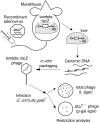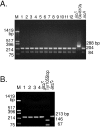A trial of somatic gene targeting in vivo with an adenovirus vector
- PMID: 16219108
- PMCID: PMC1277836
- DOI: 10.1186/1479-0556-3-8
A trial of somatic gene targeting in vivo with an adenovirus vector
Abstract
Background: Gene targeting in vivo provides a potentially powerful method for gene analysis and gene therapy. In order to sensitively detect and accurately measure designed sequence changes, we have used a transgenic mouse system, MutaMouse, which has been developed for detection of mutation in vivo. It carries bacteriophage lambda genome with lacZ+ gene, whose change to lacZ-negative allele is detected after in vitro packaging into bacteriophage particles. We have also demonstrated that gene transfer with a replication-defective adenovirus vector can achieve efficient and accurate gene targeting in vitro.
Methods: An 8 kb long DNA corresponding to the bacteriophage lambda transgene with one of two lacZ-negative single-base-pair-substitution mutant allele was inserted into a replication-defective adenovirus vector. This recombinant adenovirus was injected to the transgenic mice via tail-vein. Twenty-four hours later, genomic DNA was extracted from the liver tissue and the lambda::lacZ were recovered by in vitro packaging. The lacZ-negative phage was detected as a plaque former on agar with phenyl-beta-D-galactoside.
Results: The mutant frequency of the lacZ-negative recombinant adenovirus injected mice was at the same level with the control mouse (approximately 1/10000). Our further restriction analysis did not detect any designed recombinant.
Conclusion: The frequency of gene targeting in the mouse liver by these recombinant adenoviruses was shown to be less than 1/20000 in our assay. However, these results will aid the development of a sensitive, reliable and PCR-independent assay for gene targeting in vivo mediated by virus vectors and other means.
Figures




Similar articles
-
Somatic gene targeting with RNA/DNA chimeric oligonucleotides: an analysis with a sensitive reporter mouse system.J Gene Med. 2004 Nov;6(11):1272-80. doi: 10.1002/jgm.617. J Gene Med. 2004. PMID: 15459966
-
Positron emission tomography-based imaging of transgene expression mediated by replication-conditional, oncolytic herpes simplex virus type 1 mutant vectors in vivo.Cancer Res. 2001 Apr 1;61(7):2983-95. Cancer Res. 2001. PMID: 11306477
-
The application of the restriction site mutation assay to compare 1-ethyl-1-nitrosourea-induced mutations between the endogenous p53 gene and the transgenic LacZ gene in MutaMouse testes.Mutagenesis. 2001 Jan;16(1):59-64. doi: 10.1093/mutage/16.1.59. Mutagenesis. 2001. PMID: 11139599
-
Intratracheal injection of adenovirus containing the human MnSOD transgene protects athymic nude mice from irradiation-induced organizing alveolitis.Int J Radiat Oncol Biol Phys. 1999 Jan 1;43(1):169-81. doi: 10.1016/s0360-3016(98)00355-1. Int J Radiat Oncol Biol Phys. 1999. PMID: 9989524
-
Transcriptional targeting of replication-defective adenovirus transgene expression to smooth muscle cells in vivo.J Clin Invest. 1997 Sep 1;100(5):1006-14. doi: 10.1172/JCI119611. J Clin Invest. 1997. PMID: 9276717 Free PMC article.
Cited by
-
Expression of progerin does not result in an increased mutation rate.Chromosome Res. 2017 Oct;25(3-4):227-239. doi: 10.1007/s10577-017-9556-x. Epub 2017 May 6. Chromosome Res. 2017. PMID: 28477268 Free PMC article.
-
Characterisation of Muta™Mouse λgt10-lacZ transgene: evidence for in vivo rearrangements.Mutagenesis. 2010 Nov;25(6):609-16. doi: 10.1093/mutage/geq048. Epub 2010 Aug 19. Mutagenesis. 2010. PMID: 20724577 Free PMC article.
References
-
- Capecchi MR. Altering the genome by homologous recombination. Science. 1989;244:1288–1292. - PubMed
-
- Kren BT, Parashar B, Bandyopadhyay P, Chowdhury NR, Chowdhury JR, Steer CJ. Correction of the UDP-glucuronosyltransferase gene defect in the gunn rat model of crigler-najjar syndrome type I with a chimeric oligonucleotide. Proc Natl Acad Sci USA. 1999;96:10349–10354. doi: 10.1073/pnas.96.18.10349. - DOI - PMC - PubMed
LinkOut - more resources
Full Text Sources
Molecular Biology Databases

